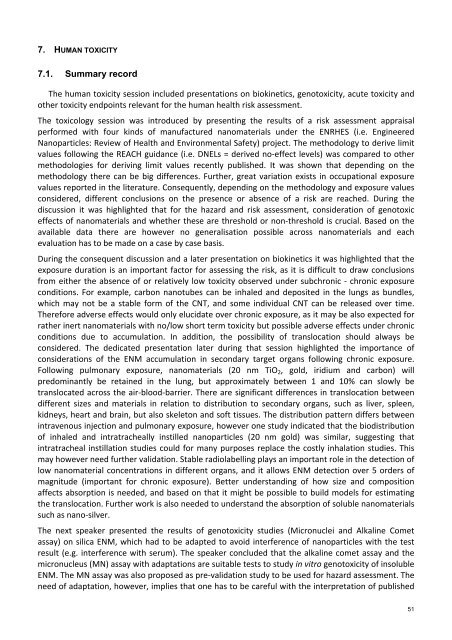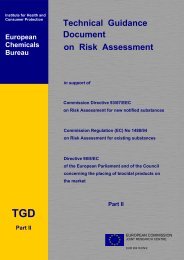Challenges of Regulation and Risk Assessment of Nanomaterials
Challenges of Regulation and Risk Assessment of Nanomaterials
Challenges of Regulation and Risk Assessment of Nanomaterials
You also want an ePaper? Increase the reach of your titles
YUMPU automatically turns print PDFs into web optimized ePapers that Google loves.
7. HUMAN TOXICITY<br />
7.1. Summary record<br />
The human toxicity session included presentations on biokinetics, genotoxicity, acute toxicity <strong>and</strong><br />
other toxicity endpoints relevant for the human health risk assessment.<br />
The toxicology session was introduced by presenting the results <strong>of</strong> a risk assessment appraisal<br />
performed with four kinds <strong>of</strong> manufactured nanomaterials under the ENRHES (i.e. Engineered<br />
Nanoparticles: Review <strong>of</strong> Health <strong>and</strong> Environmental Safety) project. The methodology to derive limit<br />
values following the REACH guidance (i.e. DNELs = derived no-effect levels) was compared to other<br />
methodologies for deriving limit values recently published. It was shown that depending on the<br />
methodology there can be big differences. Further, great variation exists in occupational exposure<br />
values reported in the literature. Consequently, depending on the methodology <strong>and</strong> exposure values<br />
considered, different conclusions on the presence or absence <strong>of</strong> a risk are reached. During the<br />
discussion it was highlighted that for the hazard <strong>and</strong> risk assessment, consideration <strong>of</strong> genotoxic<br />
effects <strong>of</strong> nanomaterials <strong>and</strong> whether these are threshold or non-threshold is crucial. Based on the<br />
available data there are however no generalisation possible across nanomaterials <strong>and</strong> each<br />
evaluation has to be made on a case by case basis.<br />
During the consequent discussion <strong>and</strong> a later presentation on biokinetics it was highlighted that the<br />
exposure duration is an important factor for assessing the risk, as it is difficult to draw conclusions<br />
from either the absence <strong>of</strong> or relatively low toxicity observed under subchronic - chronic exposure<br />
conditions. For example, carbon nanotubes can be inhaled <strong>and</strong> deposited in the lungs as bundles,<br />
which may not be a stable form <strong>of</strong> the CNT, <strong>and</strong> some individual CNT can be released over time.<br />
Therefore adverse effects would only elucidate over chronic exposure, as it may be also expected for<br />
rather inert nanomaterials with no/low short term toxicity but possible adverse effects under chronic<br />
conditions due to accumulation. In addition, the possibility <strong>of</strong> translocation should always be<br />
considered. The dedicated presentation later during that session highlighted the importance <strong>of</strong><br />
considerations <strong>of</strong> the ENM accumulation in secondary target organs following chronic exposure.<br />
Following pulmonary exposure, nanomaterials (20 nm TiO2, gold, iridium <strong>and</strong> carbon) will<br />
predominantly be retained in the lung, but approximately between 1 <strong>and</strong> 10% can slowly be<br />
translocated across the air-blood-barrier. There are significant differences in translocation between<br />
different sizes <strong>and</strong> materials in relation to distribution to secondary organs, such as liver, spleen,<br />
kidneys, heart <strong>and</strong> brain, but also skeleton <strong>and</strong> s<strong>of</strong>t tissues. The distribution pattern differs between<br />
intravenous injection <strong>and</strong> pulmonary exposure, however one study indicated that the biodistribution<br />
<strong>of</strong> inhaled <strong>and</strong> intratracheally instilled nanoparticles (20 nm gold) was similar, suggesting that<br />
intratracheal instillation studies could for many purposes replace the costly inhalation studies. This<br />
may however need further validation. Stable radiolabelling plays an important role in the detection <strong>of</strong><br />
low nanomaterial concentrations in different organs, <strong>and</strong> it allows ENM detection over 5 orders <strong>of</strong><br />
magnitude (important for chronic exposure). Better underst<strong>and</strong>ing <strong>of</strong> how size <strong>and</strong> composition<br />
affects absorption is needed, <strong>and</strong> based on that it might be possible to build models for estimating<br />
the translocation. Further work is also needed to underst<strong>and</strong> the absorption <strong>of</strong> soluble nanomaterials<br />
such as nano-silver.<br />
The next speaker presented the results <strong>of</strong> genotoxicity studies (Micronuclei <strong>and</strong> Alkaline Comet<br />
assay) on silica ENM, which had to be adapted to avoid interference <strong>of</strong> nanoparticles with the test<br />
result (e.g. interference with serum). The speaker concluded that the alkaline comet assay <strong>and</strong> the<br />
micronucleus (MN) assay with adaptations are suitable tests to study in vitro genotoxicity <strong>of</strong> insoluble<br />
ENM. The MN assay was also proposed as pre-validation study to be used for hazard assessment. The<br />
need <strong>of</strong> adaptation, however, implies that one has to be careful with the interpretation <strong>of</strong> published<br />
51








